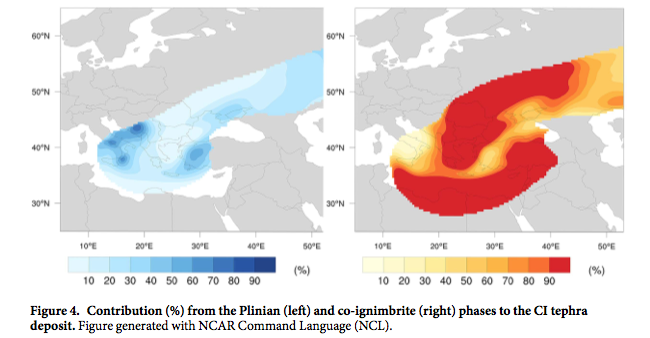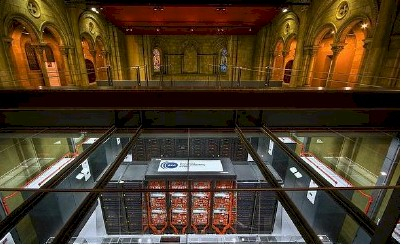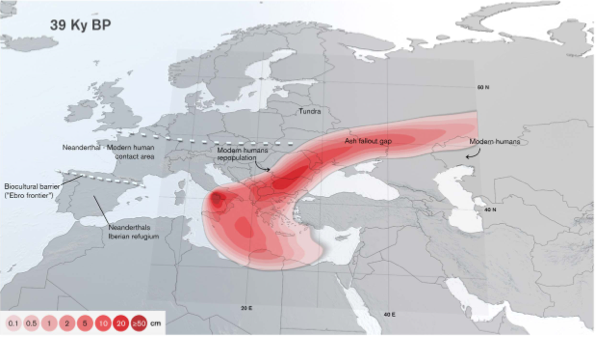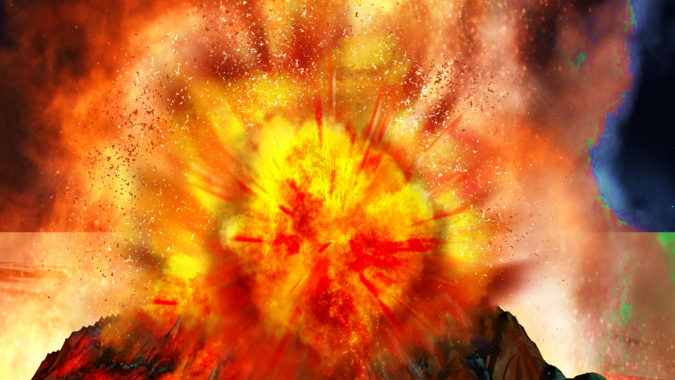About 39,000 years ago a volcanic super‐eruption tossed a volume of ash and debris equivalent to eight Mt Everest’s into the air near Naples Italy. The resulting ash plumes and rain between southern Italy and Siberia were so intense that their effects slowed the advance of modern humans in Europe. It’s thought to have been the largest eruption in Europe in the past 200,00 years.
Yesterday, researchers from Barcelona Supercomputing Center (BSC) and the Istituto Nazionale de Geofísica e Vulcanología (INGV) in Italy reported reconstructing the event – the Campanian Ignimbrite super‐eruption – with greater accuracy than ever before by running simulations on the MareNostrum supercomputer at BSC. The results, they say, improve on past efforts and strengthen the theory that event fallout interrupted the westward migration of hominids and prolonged Neanderthal survival in South-Western Europe.
Past computational studies characterized the eruption as a single-phase event although deposits indicate two distinct plume-forming phases. The new study (Reconstructing the plinian and co-ignimbrite sources of large volcanic eruptions: A novel approach for the Campanian Ignimbrite, published yesterday online in Nature Scientific Reports[i]) ran hundred of simulations for two distinct phases and required greater computational resources to complete.
“Previous numerical studies have characterized the eruption as a single-phase event, potentially leading to inaccurate assessment of eruption dynamics. To reconstruct the volume, intensity, and duration of the tephra (fragmental material produced by volcanic eruption) dispersal, we applied a computational inversion method that explicitly accounts for the Plinian and co-ignimbrite phases and for gravitational spreading of the umbrella cloud.
“To verify the consistency of our results, we performed an additional single-phase inversion using an independent thickness dataset. Our better-fitting two-phase model suggests a higher mass eruption rate than previous studies,” write the authors in the abstract. The study not only sheds more light on this particular super-eruption but also introduces a new approach to analyzing similar events. A depiction of the two separate events is below.

Access to sufficient computing power was an important element in being able to carry out the more extensive simulations. MareNostrum, an IBM machine, is the most powerful supercomputer in Spain. Currently it has a peak performance of 1.1 Petaflops, with 48,896 Intel Sandy Bridge processors in 3,056 nodes, including 84 Xeon Phi 5110P in 42 nodes, with more than 115 TB of main memory and 2 PB of GPFS disk storage. MareNostrum was 29th place in the TOP500 2013 list.
A key challenge is modernizing code to take advantage of MareNostrum capabilities, including in this instance explained Alejandro Marti, BSC researcher and co-author of the study.
“We developed on a Eulerian model for the transport and deposition of volcanic tephra (FALL3D software). The model was originally developed at the Barcelona Supercomputing Center in collaboration with the Geo-ELFS group at the INGV, Naples, Italy, and solves the advection-diffusion-sedimentation equation using a finite difference explicit scheme. It was built from the ground up to run efficiently in parallel. The MPI parallelization of the code is done at two levels, one for the particle bins and another for the computational domain,” said Marti.
“The challenge to run atmospheric transport models on MareNostrum or any other HPC environment [depends upon] on achieving optimal performance and scalability of the model,” he said.
FALL3D, which is widely used in the vulcanology community, was written in 2006 and has evolved since then, said Marti, but scaling remains an issue. “The current version of FALL3D is not able to run on massive parallelism and scalability breaks at few hundred processors. In this study we used MareNostrum to run many hundreds of runs (inversion) rather than a very large problem,” said Marti.

The inability to take advantage of MareNostrum’s full set of cores complicated the project, which consumed approximately 100,000 core hours on MareNostrum according to Marti. Efforts are already far along to remedy this.
“To circumvent this limitation we have already implemented a version of the code (still under testing) able to fully exploit HPC resources [such as] hybrid MPI-OpenMP, asynchronous communications, pre-fetching, porting to accelerator-based architectures, etc. So now a version, not used in this study, exists for accelerator-based architectures with kernels for CUDA and Xeon Phi,” he said.
Quite aside from the computational aspects of the study, the topic is fascinating. These simulations have allowed researchers to establish that in the first (Plinian) phase, the super‐eruption generated a 44‐kilometre high column and dispersed 54 km3 of fallen deposits in the surrounding areas (in what is now southern Italy). During the second (co‐ignimbrite) phase, 154 km3 of finer particles were dispersed.
In total, the super‐eruption covered an area of more than three million km2, from the Mediterranean to what is now Siberia, in ash. The largest build‐ups of ash were in modern Macedonia, Bulgaria and Romania, while in areas of the eastern Mediterranean layers up to 10cm thick accumulated. Ash movements and deposits, along with the methodology used to undertake this study, can be found on the following web page: http://www.bsc.es/viz/campanian_ignimbrite/
Using recent studies on climate cooling, the researchers estimate “the resulting stratospheric aerosol cloud from the super-eruption would have induced a “volcanic winter” with a cooling effect of ~6–9 °C in Eastern Europe26. Additionally, it has been debated that the eruption, boosted by the impact of the broadly synchronous Heinrich Event 4, contributed to the Middle to Upper Palaeolithic transition.”
A Heinrich event is a natural phenomenon in which large armadas of icebergs break off from glaciers and traverse the North Atlantic
The fallout and implications of the Campanian Ignimbrite super‐eruption are depicted in the figure below taken from the paper. As explained by the authors: “Tephra fallout, together with the attendant episode of Fenno-Scandinavian ice cap and peripheral tundra advance on land (top dashed line), suggests a reduction of the area available for human settlement in Europe of up to 30% (represented by the ash fallout gap with isopach tephra deposits in cm). Anatomically modern humans would have gravitated towards repopulating this gap after ecosystem recovery, rather that overcoming new biogeographical frontiers, leading to an instance of prolonged Neanderthal survival in Iberian Peninsula.”

This latest research represents a new more rigorous approach other may use in the future say the authors, who write:
“Commonly associated with caldera-forming events, super-eruptions often include multiple eruptive sources with different styles of ash injection. A common scenario begins with Plinian column destabilization and/or structural collapse of a caldera to produce a collapsing fountain that sheds pyroclastic flows. These high-density flows spread laterally along the ground at high-speeds, eventually leading to formation of secondary, co-ignimbrite plumes. Source conditions for co-ignimbrite plumes vary considerably from those of Plinian, with much larger source radii, lower initial ascent velocities and finer granulometry.
“However, previous numerical studies have simplified the characterization of volcanic super-eruptions to a single eruptive source, potentially leading to inaccurate estimations of their eruption dynamics. In order to evaluate the magnitude of each eruptive phase, it is critical to constrain their eruption dynamics and quantify optimal eruption source parameters (ESPs; i.e. erupted mass, mass flow rate, eruption duration, plume height and total grain size distribution) that best represent each phase of the eruption.”
[i] Reconstructing the plinian and co-ignimbrite sources of large volcanic eruptions: A novel approach for the Campanian Ignimbrite, Nature Scientific Reports, published online February 17, 2016, http://www.nature.com/articles/srep21220, Authors: Alejandro Marti (BSC), Arnau Folch (INGV), Antonio Costa (INGV), and Samantha Engwell (INGV)
Figures reproduced courtesy of the paper authors
Photo credit: Shutterstock





























































